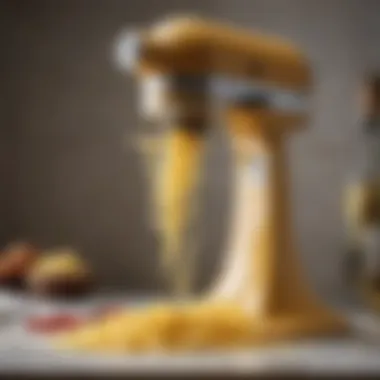Unveiling the KitchenAid Pasta Roller Set


Intro
The KitchenAid Pasta Roller Set provides an excellent opportunity for home chefs to create fresh pasta in their very own kitchens. This essential tool is not only about making pasta; it also hands users the ability to control the texture and thickness of their creations. By understanding its capabilities and maintenance, both novice and seasoned cooks can achieve remarkable results with minimal effort.
This article provides a comprehensive guide exploring the various facets of the KitchenAid Pasta Roller Set. Readers can expect to gain insights into its features, the types of pasta that can be created, and how to best maintain this valuable kitchen accessory.
Understanding how to properly utilize this tool transforms the cooking experience. It emphasizes the need for quality and usability in kitchen appliances, positioning the KitchenAid Pasta Roller Set as an indispensable asset.
Recipe Overview
Recipe Name
Fresh Fettuccine
Description of the Dish
Fettuccine is a classic Italian pasta that is flat and thick. It marries well with creamy and rich sauces. The process of making fettuccine using the KitchenAid Pasta Roller Set results in a silky and perfectly textured dish that elevates any meal. With each roll through the machine, the dough becomes increasingly refined, offering endless possibilities for homemade sauce pairings.
Ingredients
- All-purpose flour: 2 cups
- Eggs: 3 large
- Salt: 1/2 teaspoon
- Olive oil: 1 tablespoon (optional)
Special Notes on Ingredients
- Use Semolina flour for a more traditional taste and texture.
- Eggs should be at room temperature for optimal blending.
- If dietary restrictions exist, gluten-free flour can be substituted but may yield different textures.
The right ingredients are crucial in achieving the desired pasta consistency and flavor. This guide serves to clarify the essential components required while leaving room for creativity in ingredient choices.
"The essence of pasta lies in its quality. Investing in the right ingredients leads to superior results."
By understanding the significance of these elements, anyone can embark on the journey of homemade pasta, achieving both authenticity and personal preference.
Prelude to the KitchenAid Pasta Roller Set
The KitchenAid Pasta Roller Set represents a significant innovation in home cooking, particularly for those passionate about crafting their own pasta. This tool allows users to create fresh pasta easily, which enhances flavor and texture compared to store-bought options. Understanding this set's importance involves recognizing its role in bringing traditional pasta-making techniques into the modern kitchen. Whether you are a novice or a seasoned chef, the KitchenAid Pasta Roller Set offers an avenue for creativity and culinary exploration.
Moreover, using this set can significantly alter your culinary routine. Pasta is a staple in numerous cuisines worldwide. By making it from scratch, you can control the ingredients, adjust flavors, and even cater to specific dietary needs. The ability to craft pasta at home cultivates a deeper appreciation for the craft of cooking, aligning with a growing interest in homemade and artisanal foods.
Additionally, the set's design complements a robust KitchenAid mixer, which many cooks already own. This synergy transforms the kitchen into a space where traditional techniques meet modern appliances, simplifying the process of making high-quality pasta at home. Embracing the KitchenAid Pasta Roller Set can thus be viewed both as a culinary investment and a means of enriching one's cooking skills and knowledge.
What is the KitchenAid Pasta Roller Set?
The KitchenAid Pasta Roller Set consists of various attachments designed for use with a KitchenAid stand mixer. At its core, the set includes a pasta roller that rolls dough into thin sheets and additional cutters that create different pasta shapes, such as fettuccine and spaghetti. This collection is tailored to streamline the pasta-making process, making it more accessible.
By attaching the pasta roller to the mixer, users can efficiently process large batches of dough with less manual effort than traditional methods require. The equipment allows users to adjust the thickness of the pasta sheets through several settings, accommodating everything from delicate lasagna sheets to thick pappardelle. As a result, the versatility of the KitchenAid Pasta Roller Set serves both practical and creative culinary purposes.
Historical Context of Pasta Making Tools


Pasta has a rich history that dates back centuries, originating in regions like China and Italy. Over the years, the tools for making pasta have evolved significantly. Early pasta-making favored simple rolling pins and knives, requiring considerable skill and effort from home cooks. As pasta gained popularity in the 20th century, more specialized tools emerged, including manual pasta machines that offered greater convenience and consistency.
The introduction of electric appliances, like the KitchenAid mixer, transformed pasta-making once again. This evolution brought technology to the kitchen, allowing cooks to create pasta with less effort and more precision. While many traditionalists may still prefer hand-cranked methods, the KitchenAid Pasta Roller Set carries forward the legacy of pasta-making while integrating modern convenience. This blend of tradition and innovation speaks to the ongoing evolution of culinary practices, making pasta accessible to a broader range of enthusiasts and home cooks.
Components of the KitchenAid Pasta Roller Set
Understanding the components of the KitchenAid Pasta Roller Set is crucial for maximizing its utility in the kitchen. Each part plays an essential role in the process of pasta making, transforming raw ingredients into exquisite dishes. This section breaks down the various components, examining how they contribute to the overall functionality of the set. The right tools not only streamline the preparation process but also enhance the quality of the final product.
Pasta Roller Attachment
The Pasta Roller Attachment is the heart of the KitchenAid Pasta Roller Set. It allows for the rolling of dough into thin sheets, a fundamental step in producing various types of pasta. This attachment connects securely to the KitchenAid stand mixer, leveraging its powerful motor to roll out dough efficiently. The adjustable settings offer versatility, letting users choose the thickness according to their preferences.
Using the Pasta Roller is simple, yet it yields professional results. Fresh pasta made with this attachment has a texture and taste that cannot be compared to store-bought options. Additionally, the ease of use makes it appealing for both novice and experienced cooks.
Pasta Cutter Attachments
Pasta Cutter Attachments are designed to slice the rolled-out dough into different shapes and sizes. They complement the pasta roller, ensuring that users can create a variety of pasta types from one basic sheet of dough. Two notable cutter attachments are the Fettuccine Cutter and the Spaghetti Cutter.
Fettuccine Cutter
The Fettuccine Cutter is specifically tailored to create wider strips of pasta, perfect for dishes that require a robust noodle. The key characteristic of this cutter is its ability to deliver consistent results, producing uniform strands that appeal to the eye and palate alike. This cutter is a popular choice among home chefs who appreciate the classic look and feel of fettuccine.
A unique feature of the Fettuccine Cutter is its capacity to cut dough evenly, significantly reducing the time spent on this manual task. One disadvantage, however, is that it may not be suitable for thinner sauces due to the pasta's size. Nonetheless, the fettuccine works wonderfully with hearty sauces, making it an excellent addition to any meal.
Spaghetti Cutter
The Spaghetti Cutter, on the other hand, caters to those who prefer a thinner, more delicate form of pasta. This attachment creates long, slender strands, ideal for twirling on a fork with light sauces. Its key characteristic is precision; the cutter ensures each piece of spaghetti maintains a consistent thickness, contributing to even cooking.
Though it might seem standard, the Spaghetti Cutter is invaluable for various dishes—from traditional tomato-based sauces to refined seafood preparations. One advantage is its ability to accommodate different flour types, making it adaptable for home cooks experimenting with gluten-free options. However, it may require slightly more attention during cooking to avoid overcooking.
Additional Accessories
The KitchenAid Pasta Roller Set also comes with several additional accessories that elevate the pasta-making experience. These accessories enhance the versatility of the attachments, allowing for more creative culinary exploration. Common included items may feature a cleaning brush and a storage case, both essential for maintaining the equipment and ensuring longevity.
Functionality and Usage
Understanding the functionality and usage of the KitchenAid Pasta Roller Set is crucial for any home chef looking to create fresh pasta. This kitchen tool is not just a simple attachment; it elevates the experience of pasta making. The ability to customize pasta thickness and shape means that your culinary possibilities expand significantly. Through familiarization with the attachment's operation and settings, cooks can ensure better results and enhance their overall cooking skills.
Initializing the Attachment on the Mixer
To start using the KitchenAid Pasta Roller Set, proper initialization on the mixer is necessary. Begin by ensuring your KitchenAid mixer is powered off. Next, remove the hub cover at the front of the mixer. Align the pasta roller attachment with the power hub and gently push it in until it clicks into place. Make sure that the attachment is secure. Once secured, you may turn on the mixer and set it to the lower speed for a safe operation.
Adjusting Thickness Settings
The thickness settings are vital for achieving the perfect pasta. With the KitchenAid Pasta Roller, you have various thickness options, which you can adjust while the machine is running. This flexibility facilitates creating pasta sheets for lasagna to delicate tagliatelle.
Understanding Thickness Options
Thickness settings range usually from 1 to 5. Each number represents the thickness of the pasta dough. A setting of 1 produces the thickest dough, while 5 results in much thinner sheets. This option is essential for any pasta-making endeavor because different recipes call for different thicknesses.


This characteristic allows the attachment to serve multiple pasta types with ease. Understanding how to maneuver these options offers a distinct advantage since the right thickness can improve cooking times and textures. A thinner pasta cooks faster and absorbs sauces differently than thicker varieties, enhancing the dish’s flavor and overall mouthfeel.
Adjusting for Different Pasta Types
When creating different types of pasta, adjusting for the specific style is necessary. Each variety has its characteristics, and thickness plays a significant role. For example, fettuccine may require a medium thickness, whereas tortellini benefits from a thicker sheet to hold the filling without breaking.
This adjustment feature is a beneficial aspect of the KitchenAid Pasta Roller Set. It encourages experimentation and personalization in your cooking. Additionally, custom adjustments help in mastering pasta making as it invites awareness of how different thicknesses can alter the end product. This aspect alone allows cooks to develop their unique approach to pasta, which is an essential skill for any culinary enthusiast.
Making Fresh Pasta Step-by-Step
Making fresh pasta with the KitchenAid Pasta Roller Set is a straightforward process when steps are followed carefully. First, prepare the pasta dough. A simple mix of flour and eggs is typically used, but variations exist. Once the dough is ready, divide it into smaller sections for easier handling.
- Set the mixer to low and begin feeding one piece of dough through the roller. Fold the dough in half before passing it through again for better consistency.
- Gradually adjust the thickness settings as you run the dough through the roller multiple times.
- After achieving the desired thinness, switch to the cutter attachment and feed the rolled dough to shape into your preferred pasta type.
- Finally, dust the cut pasta with flour to prevent sticking and allow it to dry for a short period before cooking.
This process not only simplifies pasta creation but also assures that ingredients are fresh. The various steps ensure that enhancing fundamentals in pasta making is achieved in an organized manner.
Benefits of Using the KitchenAid Pasta Roller Set
Using the KitchenAid Pasta Roller Set can significantly enhance the home cooking experience. This tool provides not only functionality but also invites creativity into the kitchen. Understanding its benefits helps anyone considering its purchase to realize its value.
Quality of Fresh Pasta
One of the primary advantages of the KitchenAid Pasta Roller Set is the quality of fresh pasta. When the pasta is made from scratch, it is fresher than the store-bought varieties. Fresh pasta tends to have a better texture and flavor, which can elevate any dish.
The rollers provide a uniform thickness, ensuring that the pasta cooks evenly. The Motorized power of the KitchenAid mixer makes it easier to knead and roll the pasta dough versus doing it by hand. The end result is a product that is far superior in taste and quality than dried pasta. Preparing meals with high-quality ingredients always makes a difference.
Versatility in Pasta Making
The KitchenAid Pasta Roller Set is designed to cater to a variety of pasta-making needs. It allows users to experiment with different types of pasta, such as lasagna sheets, ravioli, or fettuccine. The attachments included in the set provide flexibility, enabling the creation of diverse pasta styles.
With its capabilities, one can create a range of dishes inspired by various cuisines. The ease of switching between attachments encourages exploration of regional pasta varieties. From delicate angel hair to robust rigatoni, the set supports an adventurous approach to pasta cooking. This versatility is especially beneficial for culinary enthusiasts.
Efficiency and Ease of Use
Lastly, the efficiency and ease of use of the KitchenAid Pasta Roller Set cannot be overlooked. The set streamlines the pasta-making process. It eliminates many of the tedious steps involved in traditional rolling methods. With simple adaptations to the KitchenAid mixer, users can quickly roll out sheets of pasta without excessive manual labor.
The design of the attachments allows for precise adjustments, which minimizes the effort required for preparation. Consequently, it saves valuable time in the kitchen, leaving more room for other creative tasks, such as sauce preparation or experimenting with new recipes.
"A tool that offers both efficiency and quality can redefine the way we approach our cooking, making the KitchenAid Pasta Roller Set an invaluable asset."
In summary, the benefits of the KitchenAid Pasta Roller Set are multifaceted. It not only produces superior pasta quality but also encourages culinary flexibility. Additionally, it enhances efficiency in the kitchen, making it a wise investment for anyone passionate about cooking.
Maintaining Your KitchenAid Pasta Roller Set
Maintaining your KitchenAid Pasta Roller Set is crucial for both longevity and optimal performance. Proper care ensures that the attachments remain functional and that the quality of the pasta produced stays high. A well-maintained pasta roller set not only enhances your cooking experience but also provides consistent results, making every pasta dish enjoyable.
Cleaning Process


Cleaning the KitchenAid Pasta Roller Set might seem simple, but it is essential for preserving its functionality. After each use, the rollers and cutters should be cleaned to remove any residue. First, unplug the unit and detach the roller attachment from your mixer. It is advisable to avoid using water directly on the attachments. Instead, gently brush off any flour or pasta remnants using a soft brush. You can also use a dry cloth to wipe surfaces.
Some people recommend using a thin, stiff brush to help dislodge dried bits of dough that might become stuck in the machine's rollers. In case of stubborn residue, a small amount of vegetable oil can be applied to ease the cleaning. For the pasta cutters, these should be cleaned carefully to ensure they do not lose their sharpness. Avoid immersing them in water or placing them in a dishwasher, as this may cause corrosion over time.
Storage Recommendations
When it comes to storing your KitchenAid Pasta Roller Set, there are several recommendations to follow to ensure its durability. First, always ensure that the attachments are completely dry before storing them. This helps prevent moisture buildup, which can lead to rust or mold growth.
It is best to keep the attachments in a protective case or bag to avoid scratches or other damage. Make sure to store them in a cool and dry place, away from direct sunlight. If you have limited space, consider using a designated drawer or cabinet specifically for your pasta making tools. This keeps them organized and protected from everyday kitchen activities.
"Investing time in maintenance can significantly extend the life of your KitchenAid Pasta Roller Set."
By giving attention to regular cleaning and proper storage, home cooks can ensure their KitchenAid Pasta Roller Set remains in peak condition, ready to assist in crafting delicious homemade pasta.
Exploring Different Types of Pasta
The KitchenAid Pasta Roller Set enables home chefs to create various types of fresh pasta, which enhances the culinary experience significantly. Understanding different pasta varieties is essential because each type often features distinct shapes, textures, and taste profiles that can complement unique sauces and ingredients. This section aims to explore regional pasta varieties and popular pasta dishes worldwide, allowing readers to appreciate the diversity in pasta-making and how their KitchenAid tools facilitate this journey.
Regional Pasta Varieties
Pasta is not a one-size-fits-all food. Various regions in Italy and beyond offer unique pasta styles based on local traditions and ingredients. For instance:
- Tagliatelle: Originating from Emilia-Romagna, this flat noodle pairs well with rich sauces, particularly the famous Bolognese.
- Penne: A tube-shaped pasta that hails from the Campania region, ideal for holding onto a variety of sauces.
- Fusilli: Commonly found in southern Italy, this spiral-shaped pasta is excellent for salads or hearty dishes.
- Orecchiette: This ear-shaped pasta from Puglia works best with vegetable-based sauces or simply with a drizzle of olive oil.
Understanding these varieties allows chefs to choose the right types based on their desired dishes, boosting the potential for culinary innovation. The KitchenAid Pasta Roller Set makes it easy to create these forms accurately, ensuring consistency and quality in every batch.
Pasta Dishes from Around the World
Pasta is enjoyed globally, inspiring countless dishes characterized by different techniques and ingredients. Recognizing these dishes illustrates the versatility of pasta and the ability to adapt regional preferences. Some notable pasta dishes include:
- Pasta Primavera: This dish features seasonal vegetables and a light sauce, emphasizing freshness and color. It’s popular in Italian-American cuisine.
- Macaroni and Cheese: A staple in American households, combining elbow macaroni with creamy cheese sauce offers comfort food at its best.
- Pad Thai: While primarily a noodle dish, its rice noodles and ingredients reveal pasta's diverse applications across cultures, showcasing the global reach of pasta.
- Noodles in Broth: In various Asian cuisines, similar to pasta, noodles play a vital role, often served in broth with meats and vegetables.
These examples highlight the global impact of pasta and serve as a launching point for chefs to explore new flavors and compositions. Their KitchenAid Pasta Roller Set provides the necessary tools to craft authentic versions of any pasta dish, no matter the region.
"Embracing diverse pasta types can elevate your cooking, transforming simple ingredients into exquisite meals."
By experimenting with different shapes and regional recipes, home cooks can significantly enhance their culinary repertoire, finding joy in creating new and exciting meals.
Closure: Why Invest in a KitchenAid Pasta Roller Set?
The decision to invest in a KitchenAid Pasta Roller Set encompasses both monetary and emotional considerations. Understanding why this tool merits a place in your kitchen requires an in-depth look into its overall value, functionality, and the joy it brings to the art of pasta making.
Evaluating the Cost versus Utility
When contemplating the cost of the KitchenAid Pasta Roller Set, it is essential to weigh its price against the numerous benefits it offers to home cooks. While there are more economical options available for making pasta, they often lack the precision and durability that the KitchenAid set provides. The sturdy construction and impressive longevity of the attachments make them a worthwhile investment.
- Longevity: High-quality materials contribute to the durability, ensuring the set will withstand frequent use.
- Versatility: This set is not just a one-trick pony. With various attachments, users can create diverse pasta types, making it a multifunctional kitchen appliance.
- Speed and Efficiency: Compared to manual pasta makers, the KitchenAid Pasta Roller Set drastically reduces preparation time.
In summary, the set's utility, combined with its capacity to elevate your cooking experience, justifies the price tag. Investing in this tool means being able to craft high-quality, fresh pasta at home, allowing for culinary creations that far exceed that of store-bought alternatives.
Nurturing a Culinary Passion
Investing in the KitchenAid Pasta Roller Set goes beyond practicality; it also nurtures a deeper connection to the culinary arts. For many, making pasta from scratch becomes a fulfilling ritual, providing a sense of accomplishment. This set facilitates the exploration of traditional pasta recipes from various regions, encouraging a broader understanding of global cuisines.
- Enhances Creativity: Home cooks can experiment with different ingredients and flavors, creating unique pasta dishes tailored to their taste.
- Encourages Family Engagement: Making pasta can be a group activity. Family and friends can gather in the kitchen, enhancing relationships through shared experiences.
- Satisfaction of Homemade Food: There is undeniable joy in providing a fresh, homemade meal. The textures and flavors of fresh pasta enrich the dining experience, bringing satisfaction to both the cook and the diners.







